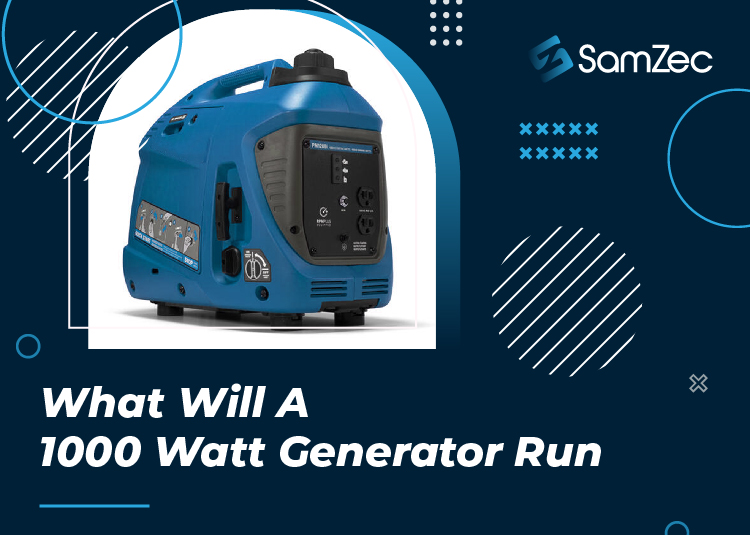I’m writing this post because I need to clear up some misinformation about generators. People are buying 1000 watt generators and running them to power their homes, but often they end up burning out quickly or die within a few minutes.
It is due to the increase in power consumption of other appliances – the other appliances add more resistance than a generator can handle! In other words, although a generator’s maximum output should be labeled as 1000 watts, you should not expect that every appliance will only draw ~1/5th of that number while still maintaining its life span.
The actual amount of watts an appliance uses depends on its efficiency level. For example:
You can use this Watts and Voltage Calculator if you want to know how many your appliances require at specific voltages.
Here’s an example using my AC unit for those who want to know What Can a 1000 Watt Generator Run? It requires 1380W vs. 1000W by itself. The reason it stays under 1000W is because my generator provides 240V (2 legs x 120V = 240). So when I turn on the AC, it essentially takes half the voltage load off compared to 120V – so they are sharing half each.
But “I thought” generators provided either 120V OR 240V? Yes, but there’s a twist! A lot of generators provide both 120V and 240V – this is called a 3-leg generator. However, most generators do not switch between each leg automatically. It means you need to manually swap the cord every time you turn it on (just like changing a socket). I sometimes forget and leave it set to one side (120V) when I use my 240V appliance.
The other option is having an automatic transfer switch installed in your home, which can handle a load of all your appliances for converting it from either voltage by itself (because both legs are always on). There will be some additional wiring requirements depending on what type of generator you’re using and exactly how far away your switch is from the generator itself.
Make sure you’re using a generator with the proper voltage/power requirements for your appliances, or this will cause them to wear out quickly!
So how much does a 1000W generator run? It runs as long as it’s not powering more than ~7000 watts total at 240V. It means if you have an AC unit, water heater, stove & oven on all at once – it will likely max out the generator’s wattage and shut off.
You’ll probably want to consider getting a bigger one (or 2x smaller ones?) if you plan on running multiple big appliances simultaneously unless without interruption. However, get an automatic transfer switch and a generator that can deliver 240V (a 3-leg model such as the Briggs & Stratton Commercial 8000E Series). You will be able to run all your large appliances simultaneously without issue ;).
Your home’s wiring may not be capable of handling the maximum watts required by your appliances. For example, older aluminum wiring (such as houses built in the ’60s through 80s) has a rating of 100-amps which is only capable of handling about ~10,000 watts total, which means 2x 5000W generators should be enough for you!
Read more: Can laptop location be tracked – Explained
For those who need to run other appliances at the same time as an AC unit (or whatever the maximum wattage is), then I would recommend getting either:
- A backup generator that can handle higher wattages like 10000W (more expensive & bigger/heavier because it has better cooling capabilities but is more powerful).
- Multiple smaller portable generators (less expensive; ea. up to ~6000 watts ).
If you don’t mind spending extra cash or want something super duper light and compact but still want the same amount of power. I would recommend something like this:
It is not a cheap generator. It runs about $1000. But if you care about your electronics and don’t ever want to worry about anything happening when you’re in a pinch (or even in general), then it will be well worth it for backup purposes.
It’s lightweight, compact, and powerful enough to run an AC unit (this one says explicitly 1350W – but that’s just what it can handle at 120V).
Furthermore, if you buy multiple generators like this and hook them up through the Y-connectors shown below, they will add their wattages together! So 2x 2000W = 4000 watts total, which is almost the same as a 5000W generator when you’re only running one appliance at a time.
Conclusion:
In conclusion, it’s all up to what appliances you’re running and What Can a 1000 Watt Generator Run? The more expensive & powerful the generator is – the longer it can run without having to shut off or cool down before starting up again (because of excess heat).
But even though less powerful generators will have lower maximum wattages they can handle per leg, most appliances with a motor will not use full power unless needed, so this shouldn’t be an issue in most cases. I don’t think any household devices use more than 2000W from either leg simultaneously? If anyone knows of one, please let me know because I would be interested in knowing.
Also, suppose you have a big generator already that doesn’t seem to power more than a few appliances at a time. In that case, it’s probably because your home wiring cannot handle 240V from both legs, which would be the maximum required to run the most appliances simultaneously without getting another generator with higher wattages.
In this case, it may be best to either get an automatic transfer switch or make sure all the appliances you want running during a power outage are on one leg and keep everything else turned off. That way, even though you’re maxing out one leg of 120V – you won’t trip any breakers/fuses and still have enough watts left over for your other devices that only use 120V (refrigerators, microwaves, etc.).




















